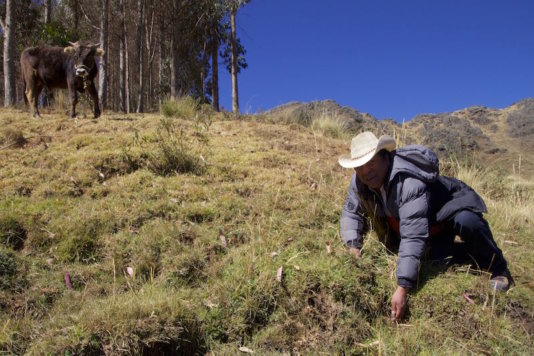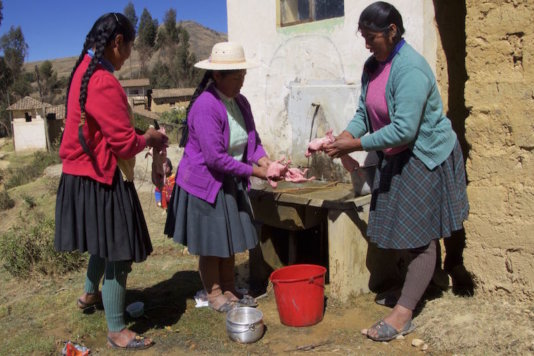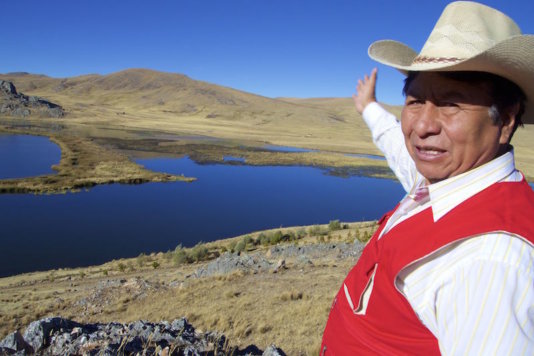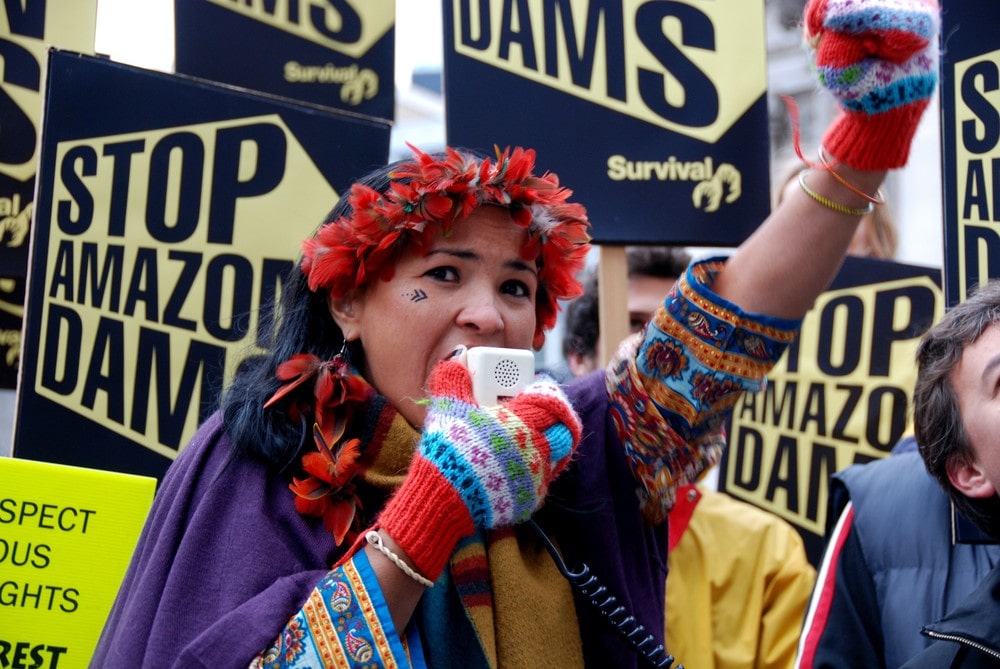- About
- Topics
- Picks
- Audio
- Story
- In-Depth
- Opinion
- News
- Donate
- Signup for our newsletterOur Editors' Best Picks.Send
Read, Debate: Engage.
| February 08, 2017 | |
|---|---|
| topic: | Innovation |
| tags: | #climate change, #Huacapunco, #Inca, #PACC |
| located: | Peru |
| by: | Pablo Pérez Álvarez |
In the Andes, the year is divided into the rainy season and the dry season. The rain which falls during the former must be sufficient for use throughout the entire year; however, the wet season has gradually shortened due to global warming and unorthodox farming practices. These include the introduction of non-native livestock and overgrazing. The indigenous population, devoted overwhelmingly to farming, is now suffering from drought. The streams and the bogs used to water their crops and nourish their cattle are drying up earlier every year.
In some areas of Peru, they are solving this shortage with the recovery of a technique called ‘water sowing’, a very simple but effective technique from Pre-Hispanic times. It consists in making qochas, small artificial lagoons, in the tops of hills in order to capture rainwater and direct it to mountain aquifers. During the dry season, the aquifers feed the streams and bogs, preventing them from drying up before the next rains.
The idea came from the Climate Change Adaptation Program (PACC, after its Spanish initials), a Swiss international cooperation project that has been active in Peru from 2009 to 2016, providing guidance to several Andean villages in the construction of qochas.
Flavio Valer, PACC’s counsellor and spearhead of the modern ‘water sowing’ initiative, explains that by capturing rainwater in the qochas and letting it infiltrate the soil “we keep springs which used to dry up in August, for the whole year”, soon after the rainy season.
In the Andes it’s usual to ‘harvest’ water, that's to say, to store it in deposits or big ponds with the bed waterproofed, to take that liquid to the places where it’s needed by pipelines. But Valer argues that it’s much more efficient the infiltration to the aquifers.
For a start, it reduces evaporation loss. Besides, it allows people to stock more liquid than the ‘harvest’ system: “I may have 5,000 cubic metres in the lagoon, but under the ground the may be 10, 20, 50 times more, depending on the kind of soil and the fissures”.
This, he says, “was used by the Incas”, the Pre-Hispanic Empire that ruled Peru and parts of neighbouring countries in the 15th Century. But, unaware of this, “in the last years, people have been using the qochas and extracting water”.
The urge to use the stocked water and the lack of a long-term vision made peasants take away the water for their cattle and crops, wasting most of it.
This frustration made the first ‘sowing’ projects necessary. Promoted by the PACC, the system was not welcomed by the peasants.
“People wanted to see water all the time. Si, all year round you have water in the qocha, it can be useful for the cattle, for example, but some of the first qochas we made dried up after three of four months. Then people felt their work had been useless. They wondered about the point of it, asked why we didn’t we waterproof the bed with plastics or use cement”, he recalls.
Nevertheless, the reward finally arrived after some months, when springs and bogs resurfaced, and the fame of this technique spread out through the Andes. It’s not only effective but also simple and cheap: “To make 20 qochas, it costs around 5,500 euros. We provide the technicians and the peasants themselves provide the workforce”, Valer adds.
In Huacapunco, a small peasant village close to Cuzco and located at 3,200 meters above sea-level had planned to make a water ‘harvest’ to relieve the increasing water shortage in their area. When searching for the funds to do it they discovered the PACC, that told them about the benefits of ‘water sowing’.
“They provided us an adviser to teach us how to make the dams, the evacuation channel and staff; and we said yes at once”, says Fernando Ucsa, Vice President of the village communal assembly.
“All of us, men and women, worked hard for six days and made nine qochas with different sizes”, he continues.
Ucsa shows some of the qochas on the top of their mountain, 1,000 meters above Huacapunco. In that arid place, exposed to the wind, the only vegetation is the ichu, a sort-of straw, the only one that grows at this altitude in a natural way, and used by llamas as pasture.
Six months after the digging of the qochas, Huacapunco’s neighbours have begun to see the profits of their work: “At this stage last year we noticed the flow decrease in the stream running near our village, but this year it remains stable. This means that these qochas are feeding it”, he assesses.
However, they expect better results: the recovery of the springs: “We know that the water must be looking for its way through the underground cracks and we are going to recover the lost springs soon”.
They hope so, even though last year the rainy season provided very little water. The peasants blame it on the effects of climate change: “We haven’t ever seen such a severe drought. It rains off season, there are frosts when they shouldn’t be and the rains are not normal. When I was 10-15 there were springs here below, but ten years ago they started to dry up, to disappear”.
Valer explains that, due to the climate change, the rainy season in the Andes is becoming shorter every year, even as the amount of water can be more intense. “Besides, in the past, the rains used to be soft, but now they are torrential. The same amount of rain that years ago used to fall throughout one night falls now in half an hour. This way, the water drains down the slope and there is no time for it to infiltrate the soil”.
Raúl Bustos, the mayor of Colquiepata, the district that Huacapunco belongs to, recalls the area was in the past “exclusively a farming zone, but in the last 15 years the population has migrated to the big cities as agriculture has declined because of the water shortage”.
This old method has led official institutions to turn to it. In the building of a dam in a lagoon placed also in the Colquepata district to supply water to several villages by pipelines, the water management Cuzco public agency (AMIA, in its Spanish acronym) decided to include the digging of trenches around it to capture de rainwater and direct it to aquifers.
“The draining water rain is intercepted by the trench, stays trapped there and infiltrates the soil little by little”, details Juan Suyo, one of the AMIA’s chief officers. This has enabled the springs in the area to start to resurface and now the neighbouring villages don’t even need to make use of the pipe lengths they are entitled to claim from the government.
“These bogs weren’t here last year”, says Suyo, satisfied, showing the small stream of water sprouting from a hole in a slope, two kilometers below the lagoon, just beside Chocopía village. The liquid makes a wet zone in the grass, and around it, it greens the yellowish vegetation dried by the blazing sun. Several cows are grazing in the fresh bog.
The success of these projects have convinced Colquepata major to take the ‘water sowing’ to other villages: “We have identified spots in four more villages to ‘sow’ water with this ancestral technique”.
Huacapunco's neighbours also want to build more qochas in their lands by themselves: “With this water, we’re never going to suffer the drought because the bogs will never dry up again”, Ferando Ucsa celebrates.
By copying the embed code below, you agree to adhere to our republishing guidelines.




